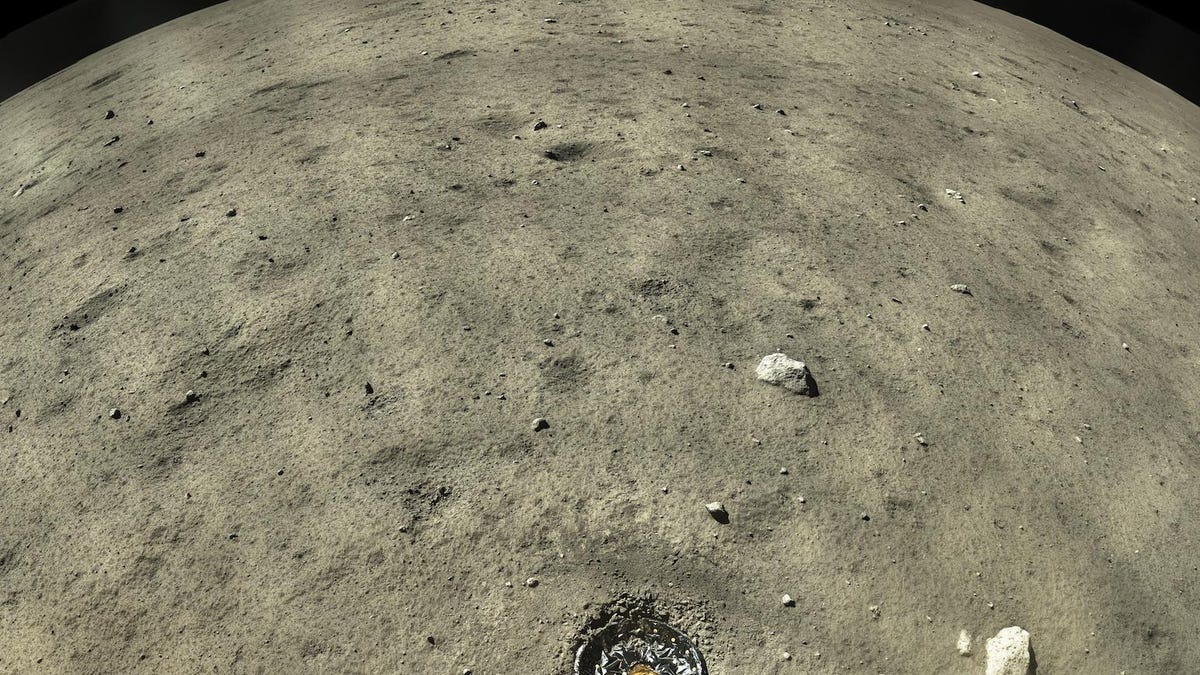China's Chang'e 5 returns to Earth loaded with moon rocks
The spacecraft has landed in Inner Mongolia, returning a sample of the lunar surface to our planet for the first time in decades.

The view from the Chang'e 5 spacecraft on the lunar landscape.
China's Chang'e 5 mission to the moon is complete less than a month after blasting off. A capsule containing samples of lunar rocks and soil collected from the surface of our natural satellite has landed in Inner Mongolia, where it will be retrieved for study.
Chinese broadcaster CGTN reported that the capsule had parachuted back to Earth just after 10 a.m. PT Wednesday. As of this writing, search crews were out in the frigid pre-dawn hours looking to retrieve the capsule from the snowy steppe amid temperatures well below zero. Aerial images appeared to show the capsule safely resting on the ground.
A closer look: pic.twitter.com/k8qOBWm2Ix
— Andrew Jones (@AJ_FI) December 16, 2020
China's National Space Administration announced Thursday, Dec. 3 that its ascent module had blasted off from atop the mission's lunar lander, carrying samples of rock and soil it drilled and scooped from the lunar surface. It then rendezvoused with an orbiter circling the moon. The pair made the return trip to Earth where the capsule carrying the samples was sent on its way for a hot and fast descent through our atmosphere only to land on frozen tundra.
WOW! Moment of ignition of the Chang'e-5 ascent vehicle pic.twitter.com/e3VJM5qiGu
— Andrew Jones (@AJ_FI) December 3, 2020
The mission lifted off from China on Nov. 23 and landed on the moon Dec. 1. Video clips from Chinese media showed the lander's robotic arm and drill hard at work during its short shift on another world.
Chang'e-5 has been busy scooping and drilling for samples from the landing site in Oceanus Procellarum. Here's gif of the scoop arm in action, placing material into the sample container. pic.twitter.com/jq0hbJwV20
— Andrew Jones (@AJ_FI) December 2, 2020
During its stay, the spacecraft also sent back the above massive panoramic view from its post on a lunar plain of relatively young volcanic moon rock.
The image above is just about half of the full high-resolution shot, which shows both distant hills from the lander's vantage point and also how the feet of the craft dug into the soft, gravel-like surface of the moon on touchdown Tuesday. (Download the whole file here.) Zooming in around the foot of the lander in particular provides a real sense of the desolate, dry, desertlike terrain.
Images purported to be from the mission have also been shared on Chinese social media, showing hundreds of images taken during the descent and landing stitched together into a single time-lapse video:
The landing of Chang'e 5's descender and ascender unit.
— LaunchStuff (@LaunchStuff) December 2, 2020
📹:CNSA/CLEP
ℹ:https://t.co/uAjm4tGl7i pic.twitter.com/P7zK9asBuq
Once the samples are collected, they will be the first pieces of the moon to be returned to our planet since the 1970s.

